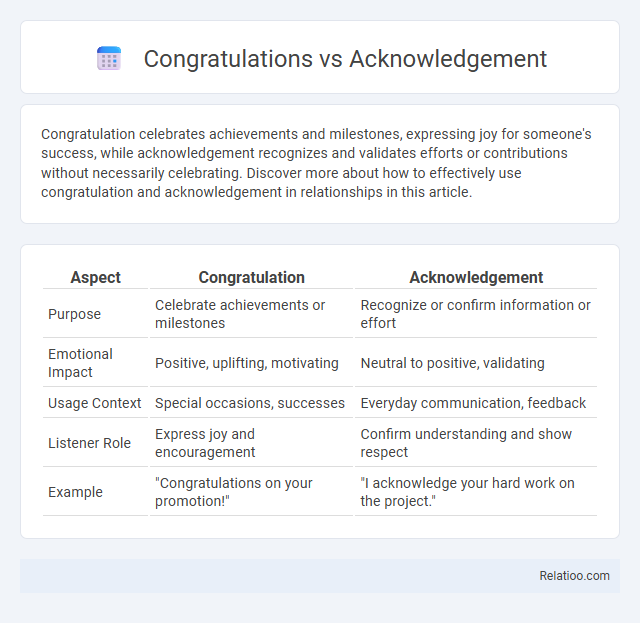Congratulation celebrates achievements and milestones, expressing joy for someone's success, while acknowledgement recognizes and validates efforts or contributions without necessarily celebrating. Discover more about how to effectively use congratulation and acknowledgement in relationships in this article.
Table of Comparison
| Aspect | Congratulation | Acknowledgement |
|---|---|---|
| Purpose | Celebrate achievements or milestones | Recognize or confirm information or effort |
| Emotional Impact | Positive, uplifting, motivating | Neutral to positive, validating |
| Usage Context | Special occasions, successes | Everyday communication, feedback |
| Listener Role | Express joy and encouragement | Confirm understanding and show respect |
| Example | "Congratulations on your promotion!" | "I acknowledge your hard work on the project." |
Understanding Congratulations and Acknowledgement
Understanding congratulations involves recognizing it as an expression of joy or praise for someone's achievement or success, often delivered verbally or through a card. Acknowledgement, by contrast, is the act of recognizing or admitting the existence or truth of something, which may not always convey emotion or celebration but rather appreciation or recognition. When you differentiate congratulations from acknowledgement, you clarify that congratulations celebrate and acknowledge achievements, while acknowledgement alone may simply affirm facts or contributions without festive intent.
Definition of Congratulations
Congratulations express joy and recognition of someone's achievement or special occasion, often conveyed to celebrate success, milestones, or positive accomplishments. Acknowledgement refers to the act of recognizing or admitting the existence or truth of something without the celebratory tone. Your use of congratulations conveys sincere praise and goodwill, distinguishing it from the more neutral confirmation implied by acknowledgement.
Definition of Acknowledgement
Acknowledgement refers to the act of recognizing or admitting the existence, validity, or truth of something, often serving as a formal or informal expression of appreciation or awareness. Unlike congratulation, which directly celebrates an achievement or success, acknowledgement can simply validate effort, receipt, or understanding without necessarily implying celebration. Your ability to provide clear acknowledgement enhances communication by ensuring that contributions or information are properly recognized.
Key Differences Between Congratulations and Acknowledgement
Congratulations express praise and joy for someone's achievement or milestone, often including personal or public recognition of success. Acknowledgement refers to the act of recognizing or accepting the existence or truth of something, typically without emotional emphasis or celebration. The key difference lies in the intent: congratulations convey positive reinforcement and celebration, whereas acknowledgement serves as a formal or neutral recognition without necessarily implying approval or excitement.
Appropriate Contexts for Using Congratulations
Use congratulations when celebrating achievements, milestones, or positive events such as graduations, promotions, or weddings to express genuine joy and recognition. Acknowledgement suits situations requiring formal or neutral recognition of facts, efforts, or attendance without emotional emphasis. Congratulate appropriately by matching the tone and relationship to the recipient, ensuring heartfelt messages for personal successes and professional accomplishments.
Appropriate Contexts for Using Acknowledgement
Acknowledgement is best used in professional or formal contexts to recognize receipt of information, contributions, or efforts without implying celebration, unlike congratulation which expresses joy for achievements or milestones. You should choose acknowledgement when thanking someone for participation, confirming understanding, or appreciating assistance without the emotional tone of congratulation. Proper use of acknowledgement maintains professionalism and clarity, especially in business communications or official correspondence.
Common Mistakes in Using Congratulations and Acknowledgement
Common mistakes in using congratulations and acknowledgement often involve confusion between expressing praise and simply recognizing information. Congratulations is used to celebrate achievements or milestones, while acknowledgement is appropriate for noting receipt of information or showing awareness without celebration. Misusing congratulations in formal communications where acknowledgement is intended can lead to misunderstandings and appear insincere.
Examples of Congratulations in Professional Settings
Examples of congratulations in professional settings include praising a colleague for a successful project completion, acknowledging a promotion with a thoughtful note, or celebrating team achievements during meetings. Your recognition of these milestones boosts morale and fosters a positive workplace culture. Effective congratulations demonstrate appreciation and encourage continued excellence in professional environments.
Examples of Acknowledgement in Professional Settings
Acknowledgement in professional settings often involves recognizing receipt of documents, confirming understanding of instructions, or appreciating contributions without overt celebration, such as sending a brief email stating, "Received your report and will review it by Friday." Unlike congratulations, which explicitly celebrate achievements with phrases like "Congratulations on your promotion," acknowledgement maintains professionalism and clarity, ensuring effective communication. Examples include acknowledging meeting invitations, project updates, or feedback, fostering a respectful and efficient work environment.
Tips for Choosing Between Congratulations and Acknowledgement
Choosing between congratulations and acknowledgement depends on the context and the intention behind the message. Use congratulations when recognizing achievements, milestones, or successes that warrant celebration and positive reinforcement. Opt for acknowledgement to formally recognize efforts, presence, or contributions without necessarily implying celebration, ensuring clarity and appropriateness in professional or neutral communications.

Infographic: Congratulation vs Acknowledgement
 relatioo.com
relatioo.com